
The Aizoaceae, or fig-marigold family, is a large family of dicotyledonous flowering plants containing 135 genera and about 1800 species. They are commonly known as ice plants or carpet weeds. They are often called vygies in South Africa and New Zealand. Highly succulent species that resemble stones are sometimes called mesembs.

In botany, phyllotaxis or phyllotaxy is the arrangement of leaves on a plant stem. Phyllotactic spirals form a distinctive class of patterns in nature.

Lithops is a genus of succulent plants in the ice plant family, Aizoaceae. Members of the genus are native to southern Africa. The name is derived from the Ancient Greek words λίθος, meaning "stone," and ὄψ, meaning "face," referring to the stone-like appearance of the plants. They avoid being eaten by blending in with surrounding rocks and are often known as pebble plants or living stones. The formation of the name from the Ancient Greek "-ops" means that even a single plant is called a Lithops.

Lampranthus is a genus of succulent plants in the family Aizoaceae, indigenous to southern Africa.

Conophytum is a genus of South African and Namibian succulent plants that belong to the family Aizoaceae. The name is derived from the Latin conus (cone) and Greek phytum (plant). The plants are also known as knopies, waterblasies, sphaeroids, conos, cone plants, dumplings, or button plants.
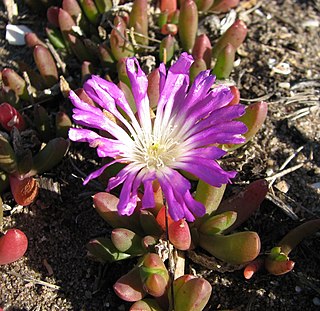
Disphyma is a genus of flowering plants in the family Aizoaceae that are native to New Zealand, Australia and southern Africa. Plants in this genus are prostrate, annual or short-lived perennial shrubs with succulent leaves and daisy-like flowers arranged singly on the ends of shoots with petal-like staminodes, many stamens and usually five styles.
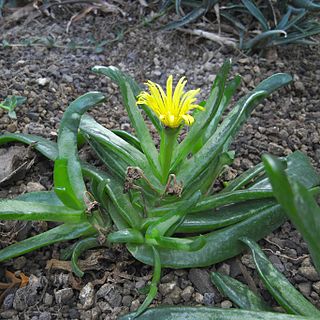
Glottiphyllum is a genus of about 57 species of succulent subtropical plants of the family Aizoaceae. It is closely related to the Gibbaeum and Faucaria genera. The name comes from ancient Greek γλωττίς glottis "tongue" and φύλλον phyllon "leaf". The species are native to South Africa, specifically to Cape Province and the Karoo desert. They grow in rocks and soils incorporating slate, sandstone and quartz. Rainfall in their native areas is between 125 and 500 mm, most of which falls in March and November.

Glottiphyllum longum is a species of succulent plant in the family Aizoaceae, native to the Western Cape and Eastern Cape Provinces, South Africa.
Gert Cornelius Nel was a South African botanist. His formal botanical author abbreviation is Nel.

Glottiphyllum cruciatum is a rare species of succulent plant, of the family Aizoaceae. It is indigenous to arid areas near Oudtshoorn in the Western Cape, South Africa. The plant has many synonyms including Glottiphyllum angustum.

Glottiphyllum peersii is a rare species of succulent plant, of the family Aizoaceae. It is indigenous to arid areas near Klaarstroom in the Western Cape, South Africa.

Glottiphyllum depressum is a common species of succulent plant, of the family Aizoaceae, native to South Africa.
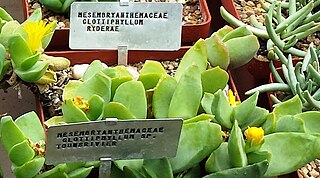
Glottiphyllum linguiforme is a widespread species of succulent plant, of the family Aizoaceae, native to South Africa. It is the type species of the genus Glottiphyllum.
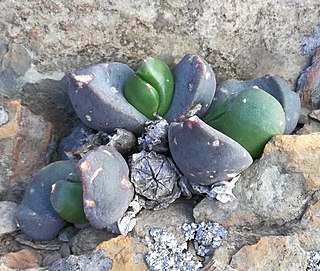
Glottiphyllum suave is a species of succulent plant, of the family Aizoaceae. It is indigenous to arid areas of the western Little Karoo, in the Western Cape, South Africa.

Glottiphyllum oligocarpum is a species of succulent plant, of the family Aizoaceae. It is indigenous to arid areas of the Little Karoo, in the Western Cape, South Africa.

Glottiphyllum fergusoniae is a species of succulent plant, of the family Aizoaceae. It is indigenous to the western part of the Little Karoo, in the Western Cape, South Africa.
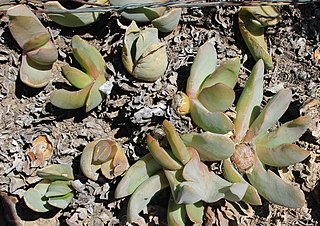
Glottiphyllum carnosum is a rare species of succulent plant, of the family Aizoaceae. It is indigenous to arid areas between the towns of Calitzdorp and Oudtshoorn in the Western Cape, South Africa. It co-occurs with several other species of Glottiphyllum.
Lithops divergens is a succulent plant species of the genus Lithops under the family Aizoaceae. It grows around the regions of Southern Africa and it able to withstand intense climatic changes due to its resilience as a succulent. The average rainfall for its natural environment is less that 500mm.
Trichodiadema attonsum is succulent plant of the genus Trichodiadema, native to the Western Cape Province, South Africa, where it is common among pale quartzite rocks in the western Little Karoo region. Unlike most other species in its genus, it does not have a typical diadem on its leaf-tips.

Trichodiadema barbatum is succulent plant of the genus Trichodiadema, native to the Eastern Cape Province, South Africa.

















